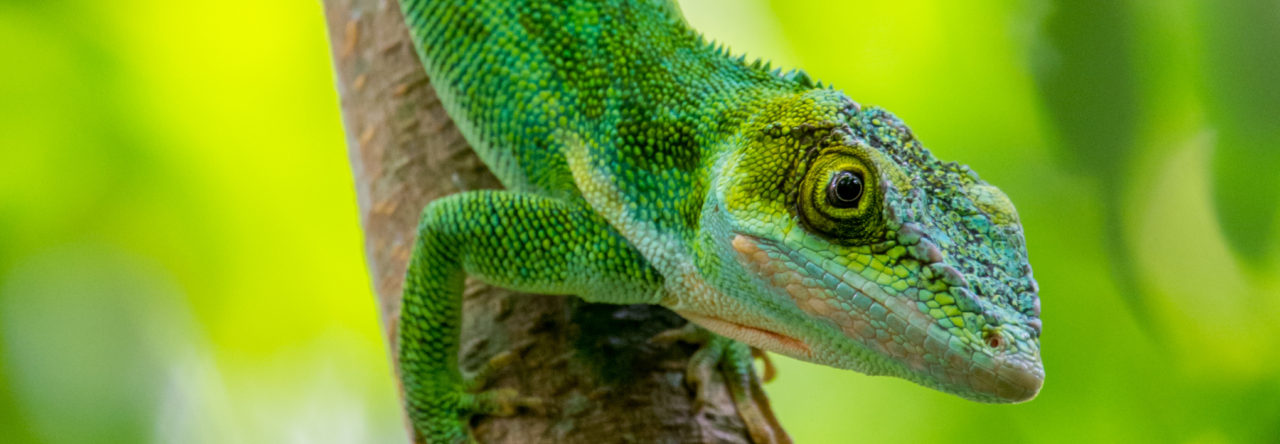Did you ever read those choose-your-own-adventure books as a kid? I had a whole collection. What if lectures were like that too? Check this one out on anoles (above).
This lecture came about from the need to update a lecture on ecological competition for a second year undergraduate course. In the past, someone might have handed me a textbook and I would have quickly shelved it, never having opened its cover. As a student I hated textbooks and things really haven’t changed for me now as an educator. The real challenge isn’t the content, it’s presenting that content effectively. We’re now on the other side of “the great digital shift of 2020,” but this challenge of engagement remains the same, if not more so. Does this choose-your-own-adventure lecture offer the solution?
Let’s step back for a moment so I can first make the case for anoles…
Anoles first came into view for me way back in my first year of graduate school. Not in real life, of course — there were no anoles at any of my field sites in Sydney. Instead, I happened across a remarkable paper appearing in one of the weekly tabloids. It recounted how researchers had returned to some tiny islands in the Bahamas where a bunch of lizards had been introduced a decade or so before. I couldn’t make head nor tail of the PCA plots or Tables. But the scatterplot later in the paper was clear to even a dunce like me. These lizards had adapted their limbs over a matter of years (years!) to cope with living on spindly bushes. Evolution happening in real-time? Holy cow, this was revolutionary for me. Why am I only seeing this now?
I’d never really thought about adaptation outside of centuries or millions of years. But then my undergraduate experience was the usual, tired textbook fodder of ecology and evolution that never came to life, regardless of how glossy the graphics might have been. My undergraduate experience was mostly about memorising facts and figures, and there was a great mental chasm between those and the real world around me. What I actually saw in nature were animals doing weird and crazy things, so I ultimately gravitated towards animal behaviour for my PhD. But when I discovered this paper, I had just finished reading Richard Dawkin’s “selfish gene” and Dan Dennett’s “Darwin’s dangerous idea,” and I was now fascinated by evolution.
And here was some character named Jonathan Losos, along with his mates Ken Warheit and Tom Schoener, reporting in a glossy magazine called ‘Nature’ years before (in 1997 no less) that evolution happens now, not in the past… Now! If only I had been exposed to this and other stuff like it as an undergraduate. [NB: Jonathan gives a great backstory in his book about how this study almost never left the bottom drawer].
These days I am towards the other end of the student-teacher continuum and I make a point of not teaching from a textbook. First, they are WAY too expensive for students. Second, they are out of date by the time they are published. Third, if classic works are covered (like those on anoles), the format of a textbook makes even the most exciting example remote and dull. My approach has always been to go directly to the source. And anoles offer such a rich collection of content for educators.
But what of this new “choose-your-own-adventure” style format? What is really being achieved here? My sales pitch to you is that it prompts student engagement at strategic points. By doing so, it maintains an active connection between the student and the content. In other words, it should stop students cognitively dropping out while writing copious amounts of notes that they will only ever read just before the exam and promptly forget soon afterwards. By forcing students to direct their own learning experience, they are being subtly pushed to reflect on the content explicitly and intuitively, and they might not even realise it. The hope is they not only grasp the concepts being presented more effectively, but retain (and apply) that comprehension outside the bounds of the course and into the future. And it’s fun too.
Convinced?
The danger is the format could just be a gimmick that’s great as a one-off, but quickly becomes annoying or distracting. The analogy I think of here is the transition from slides to powerpoint in my early conference days at the start of the 2000s. For the ancients among you who remember that time, you might recall having to sit through a plague of animated slide transitions with cheesy swirly sounds as presenters explored the seemingly infinite number of options on offer. Oh, the liberation of going digital! Then most of us eventually realised how annoying and distracting it all was and went back to simpler presentations. Perhaps “choose-your-own-adventure” lectures are the same? Would you have an entire course with choose-your-own-adventure lectures?
Huge thanks to Mike Kasumovic and Arludo for both the hideous yellow shirt and putting the lecture together for me. I use a lot of Arludo’s interactive digital games in my teaching as well – they’re free, the students love them, and they have clear educational outcomes. Evolution, ecology or behaviour, whatever you need, they’ll have something you can engage your students with. Do check them out.



















